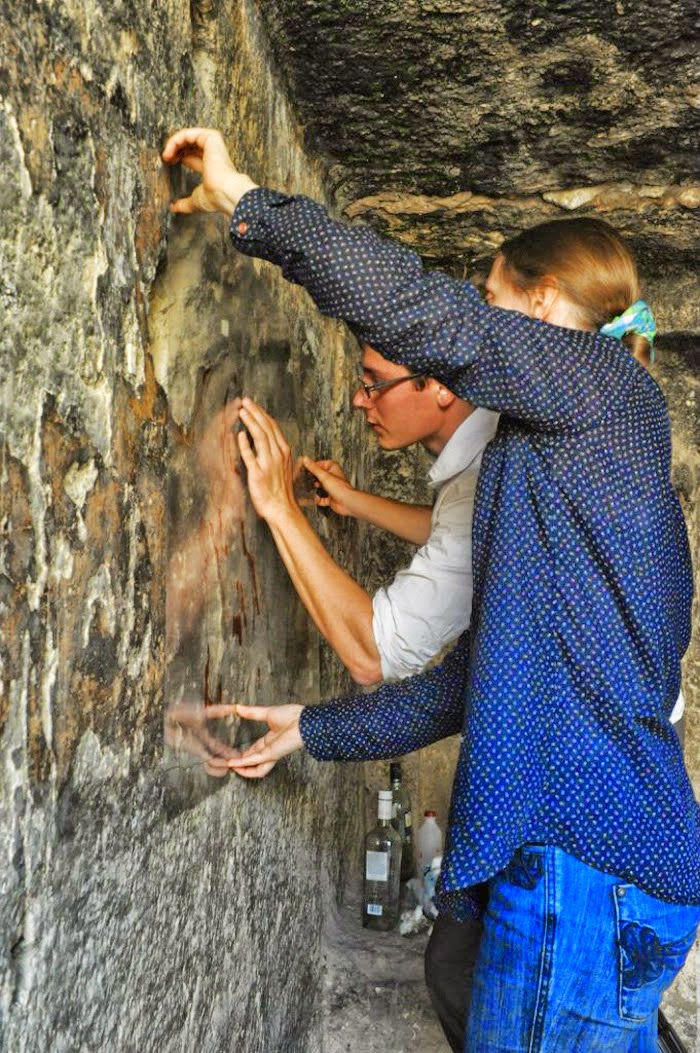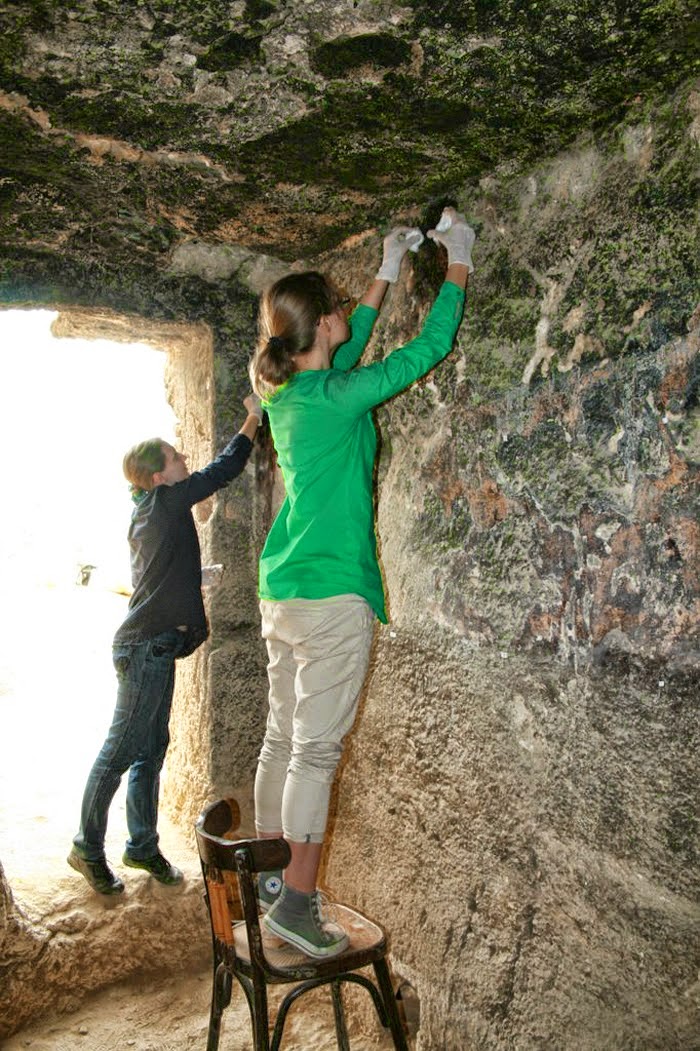Appena ad Est dalla Piramide di Giza (300 metri appena) sono stati coronati da buon esito scavi congiunti, iniziati nel 96... I dipinti, scoperti già nel 2012 sono stati infine restaurati e possono oggi essere visti... La tomba è risultata essere quella di Perseneb, descritto come 'sacerdote' e 'maggiordomo'.
La tomba si compone di tre stanze. Si pensava che non potesse offrire alcunché di nuovo, anche per il fatto che era stata aperta e riusata dall'uomo: per esempio, era stata abitata nel medioevo.
In più, l'inquinamento del Cairo aveva coperto di una patina scura tutte le originale sottile, bianco, di cui resta solo circa il 30%: non vi si indovinava alcunché.
Invece, sono saltate fuori rappresentazioni di vita antica, di Perseneb, la moglie ed il cane. Antichi paesaggi e navi che veleggiano verso il sud, nel Nilo.
Si pensa che la tomba risalga alla V Dinastia (ca. 2450-2350 a.C.). Le implicazioni simbolico religiose dei dipinti sono potenti: la caccia agli uccelli nella palude si riferisce probabilmente alla sottomissione del Caos naturale e possiede probabilmente implicazioni con la vita eterna.
Ma gli archeologi trovano estremamente interessanti anche quelle scene che sembrano essere solamente scene di vita agropastorale quotidiana.
E sono molto ottimisti per ciò che può saltar fuori dallo studio delle altre numerosissime tombe che si trovano nella zona e che presentano condizioni di riuso analoghe, ma migliore stato di conservazione.
Questo post dimostra che preziosi (seppure apparentemente scarsi) risultati archeologici si ottengono solo in anni ed anni di ricerca da parte di intere squadre di ricercatori preparati. Ed è dedicato proprio a quei ciarlatani che credono di darla a bere sempre a tutti con la loro presunta 'ricerca' arrogante e velleitaria. Ricordo che proprio per loro Abraham Lincoln disse: "Puoi ingannare tutta la gente per parte del tempo, o parte della gente per tutto il tempo, ma non puoi ingannare tutta la gente per tutto il tempo".
You can fool all the people some of the time, and some of the people all the time, but you cannot fool all the people all the time.
Wall painting discovered in priest's tomb at Giza
----
A wall painting, dating back over 4,300 years, has been discovered in a tomb located just east of the Great Pyramid of Giza.
Part of the wall painting after cleaning is shown here.
The painting, dating to the middle or late fifth dynasty (ca. 2450-2350 B.C.), has a lengthy agricultural scene that includes the driving of sheep
[Credit: Maksim Lebedev]
The painting shows vivid scenes of life, including boats sailing south on the Nile River, a bird hunting trip in a marsh and a man named Perseneb who's shown with his wife and dog.
While Giza is famous for its pyramids, the site also contains fields of tombs that sprawl to the east and west of the Great Pyramid.
These tombs were created for private individuals who held varying degrees of rank and power during the Old Kingdom (2649-2150 B.C.), the age when the Giza pyramids were built.
The new painting was discovered in 2012 by a team from the Institute of Oriental Studies of the Russian Academy of Sciences, which has been excavating these tombs since 1996.
A surprise discovery Scientists discovered the painting when they began restoring the tomb of Perseneb, a man who was a "priest" and "steward," according to the tomb's inscriptions. The remains of the painting were found here on the eastern wall of the central room of the tomb near the Great Pyramid at Giza.
The painting required extensive cleaning and restoration in order to reveal what the images show [Credit: Maksim Lebedev]
His tomb, located 1,000 feet (300 meters) east of the Great Pyramid of Giza, contains an offering room, central room and burial chamber.
The three rooms contain 11 statues showing depictions of Perseneb and members of his family. First recorded in the 19th century by the German explorer Karl Richard Lepsius and French Egyptologist Auguste Mariette, the tomb is believed to date to the middle or late fifth dynasty (ca. 2450-2350 B.C.).
The fifth dynasty is a time period within the Old Kingdom.
"Known since the 19th century, the [tomb] could hardly present any new principal features. Therefore, it was a real surprise to discover an Old Kingdom painting on the eastern wall of the central room," wrote Maksim Lebedev, a reader (the American equivalent is a professor) at the Russian State University for the Humanities, in an email to Live Science.
Archaeologists removed dirt and soot from the tomb painting
[Credit: Maksim Lebedev]
"The painting was made on a thin layer of fine white plaster darkened with 19th-century soot and dirt.
By the time of recording, only about 30 percent of the original plaster had preserved on the wall," Lebedev said. Since the 19th century, the growth and industrialization of Cairo has led to problems with pollution at Giza.
And the fact that people were actually living inside the tomb in some periods (including the Middle Ages) also damaged the painting, Lebedev said. Nevertheless, "none of the scenes has been lost completely. The remaining traces allow [for the] reconstruction [of] the whole composition," Lebedev said.
Scenes of life The reconstructed painting reflects ancient life.
At the top of the painting there are images of boats sailing the Nile River, their sails pointing south. They "probably represent the return of the owner from the north after a pilgrimage or inspection of his funerary estates," Lebedev said.
Funerary estates were tax-exempt property left by the deceased to help support surviving dependents and the upkeep of his tomb.
Archaeologists also traced the tomb painting, located near Egypt's Great Pyramid at Giza, allowing for the images to be reconstructed.
The painting showed scenes of ancient life, such as boats sailing on the Nile River and a hunting trip for birds near a marsh
[Credit: Maksim Lebedev]
The painting's "two lower registers preserved representations of various agricultural scenes: plowing, sowing, workers driving sheep over sown seed, driving donkeys laden with sheaves to the threshing floor," Lebedev said.
The painting also shows an image of Perseneb, his wife and what appears to be his dog. There is also a marsh scene with a man on a boat who appears to be bird hunting. "All the depicted scenes had important symbolic meanings. Fowling (bird hunting) in the marshland could refer to the ideas of rebirth and taming of chaotic forces," Lebedev said.
"The full agricultural sequence relating to crops represents the most crucial event in the life of ancient Egyptian society," he added. Also, the representation of "boats with sails going southwards is another important tomb subject, which reflected the high status of the person."
More discoveries to come The area the Russian team has been excavating contains a number of tombs that may hold undiscovered wall paintings. The team has found indirect evidence for paintings in some tombs, such as very smooth walls and remains of wall plaster and paint, Lebedev said.
The new painting, depicting scenes of ancient Egyptian life, was discovered in 2012 in a tomb located about 1,000 feet (300 meters) east of the Great Pyramid at Giza.
Pictured here the tomb is for a man named Perseneb whom inscriptions say was a "priest" and "steward." It dates to the middle or late fifth dynasty (ca. 2450-2350 B.C.) [Credit: Maksim Lebedev]
"Since many rock-cut chapels of the eastern edge of the Giza plateau were rapidly excavated or just recorded [without excavation] in the first half of the 20th century, sometimes without sufficient documentation, and still covered with thick layers of rough plaster left from later inhabitants [who lived in the tombs], one may expect that more paintings will be discovered in this part of the necropolis."
The tomb of Perseneb was partly restored by the Russian mission in 2013.
The work was supported by a donation from the Thames Valley Ancient Egyptian Society in the United Kingdom.
The painting reconstructions will be published, in full, in a scholarly publication in the future. The images on Live Science show just a few of the reconstructed scenes.
Author: Owen Jarus
| Source: LiveScience [July 15, 2014]
Read more at: http://archaeologynewsnetwork.blogspot.it/2014/07/wall-painting-discovered-in-priests.html?utm_source=feedburner&utm_medium=feed&utm_campaign=Feed:+TheArchaeologyNewsNetwork+(The+Archaeology+News+Network)#.U85CDyh7DfX
Follow us: @ArchaeoNewsNet on Twitter | groups/thearchaeologynewsnetwork/ on Facebook





